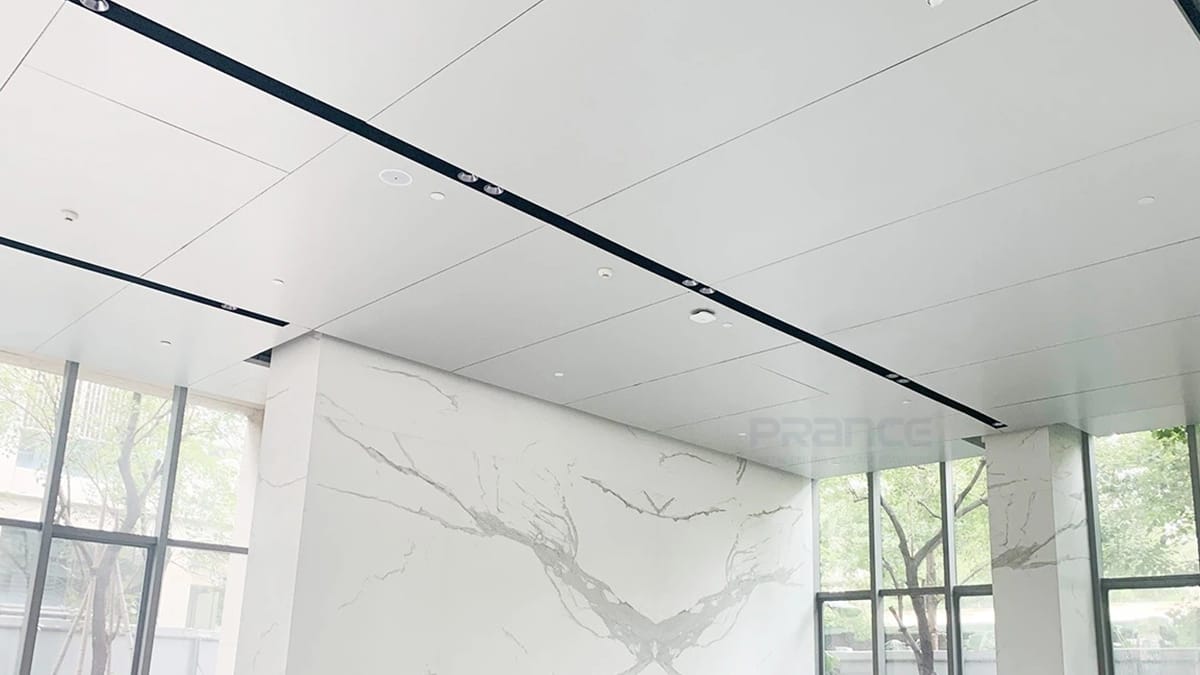
03 Oct ACP Sheet Ceilings vs Traditional Materials Which Is Right for Your Space
Table of Contents
If you want your ceiling to look modern and smooth, you might like an acp sheet ceiling. If you want a classic look or need to save money, traditional materials like gypsum or PVC may be better. What you pick depends on what is most important to you. Think about durability, cost, how it looks, how much care it needs, how fast it can be put in, fire safety, and where you will use it.
Factor | ACP Sheets | Traditional Materials |
|---|---|---|
Project Scale and Type | Good for big projects | Good for special designs and details |
Budget and Timeline | May take more time and money | |
Sustainability | Can be recycled and saves energy | Depends on what it is made of |
Key Takeaways
ACP sheet ceilings look modern and are light. This makes them easy to put up and move.
Traditional materials like gypsum and PVC cost less at first. But they might need more fixing and care later.
Think about fire safety when picking a ceiling. ACP panels stop fire better than PVC and other old materials.
You can change both ACP and old materials in style and color. This helps you match your ceiling to your room’s look.
Look at what your project needs, like strength, care, and money. This helps you pick the best ceiling for your space.
ACP Sheet Ceiling Overview
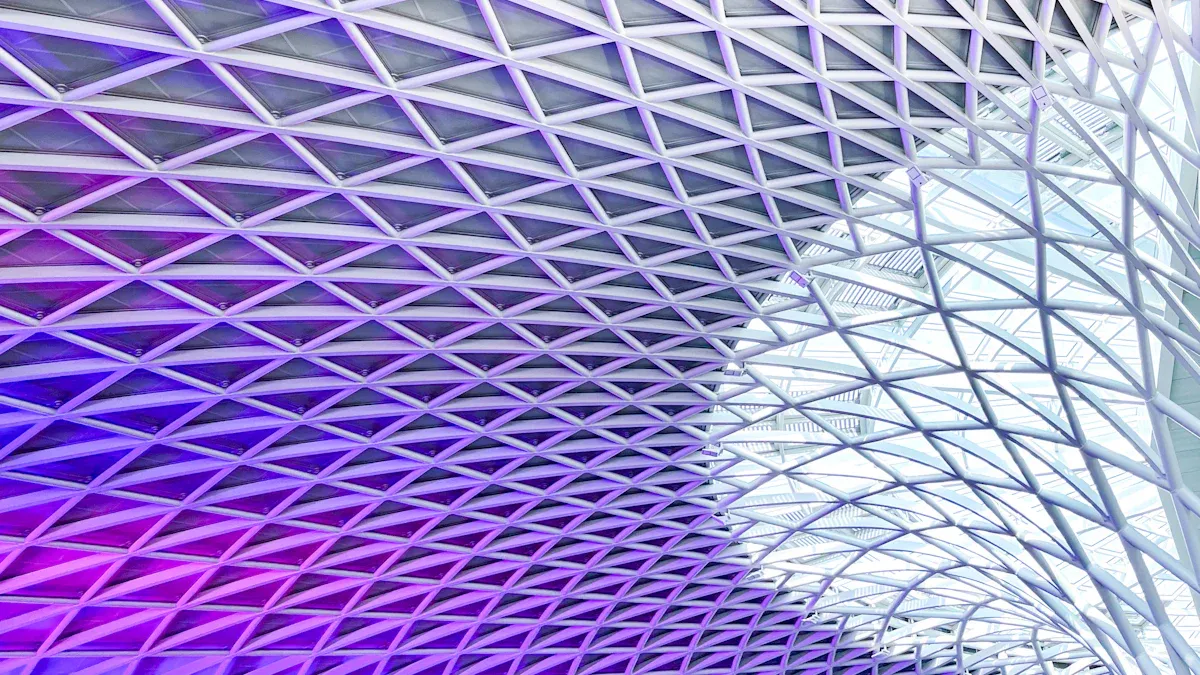
What Is an ACP Sheet Ceiling
You might wonder what makes an acp sheet ceiling different from other ceilings. ACP stands for aluminium composite panels. These panels use a mix of aluminum sheets and a polyethylene core. This combination creates a strong and lightweight cladding material. You get a ceiling that looks sleek and modern, but also stands up to daily wear.
Let’s break down how acp ceilings are made:
Manufacturers melt the polyethylene core using heat extrusion.
They clean the aluminum coils to remove any dirt or oil.
The polyethylene core gets sandwiched between two aluminum sheets with high pressure.
A protective coating is added for extra durability.
Surface treatments and color options allow you to match your style.
Each panel goes through strict quality checks.
The main parts of acp sheet ceiling panels include:
Aluminum sheets for the outer surfaces.
Polyethylene core for strength and insulation.
Protective coatings to resist moisture and scratches.
You’ll also see hpl sheets used in some designs. These add even more strength and style to the cladding.
Tip: ACP ceilings are not just for looks. Their cladding helps with insulation and keeps your space comfortable.
ACPs in Ceiling Design
If you want a ceiling that fits modern trends, acps are a smart choice. ACP sheet ceiling panels give you a smooth finish and plenty of color options. You can pick bold shades or subtle tones to match your space. Architects love acp ceilings because they are easy to install and customize.
ACPs work well in offices, shops, and homes. Their lightweight cladding makes them simple to handle. You can use hpl sheets for extra durability or special textures. ACP ceilings also help with sound and heat insulation, so your room feels cozy.
Aluminium composite panels are popular for their clean look and strong cladding. You get a ceiling that lasts and stays stylish. If you want a ceiling that stands out, acp sheet ceiling panels and hpl sheets can help you create the perfect design.
Traditional Materials
Gypsum
Gypsum is used in many ceilings. It sets fast, so projects finish quickly. Gypsum helps keep the air inside steady. This makes rooms feel comfortable. It slows down fire because it has water inside. You do not need to worry about cracks. Gypsum gets a little bigger when it sets. This helps make smooth finishes. Here are some main features:
Property/Feature | Description |
|---|---|
Fast Setting and Hardening | Gypsum sets fast. It is good for quick building and repairs. |
Humidity Regulation Capability | It helps keep indoor air steady with its hydration cycle. |
Excellent Fire Resistance | Water inside slows heat and stops flames from spreading. |
No Shrinkage, Slight Expansion | It gets a bit bigger when setting, so cracks are less likely. |
Lightweight and Insulating | It is light and keeps heat out, good for inside use. |
Poor Water and Frost Resistance | It does not do well with water or cold, so not for outside or wet places. |
Tip: Gypsum works best inside. For wet rooms, try other materials.
PVC
PVC sheets are common in homes and offices. They give a smooth look and come in many colors. PVC sheets are light and easy to put up. They last a long time, so you do not replace them often. But they can hurt the environment:
PVC sheets are made from plastic. Making them uses lots of energy and chemicals.
They do not break down in landfills, so they add to waste.
Some PVC sheets use recycled plastic, but recycling is hard to do for many sheets.
Because they last long, you throw away fewer panels.
If you want a ceiling that looks modern and is easy to clean, PVC sheets may be a good choice.
POP
POP means Plaster of Paris. You can make cool designs and shapes with it. POP lets you mold many patterns, so your ceiling stands out. It is cheap and sets up fast. Here is what you get:
You can make fancy patterns for a nice look.
POP works with different ceiling heights and shapes.
You save money compared to gypsum board.
It is quick to install.
But POP has some problems. It cracks in wet rooms. It needs cleaning often. It is heavier than other cladding. It does not keep heat or sound out well. The work can get messy with dust and bits during setup.
Solid Aluminum
Solid aluminum panels make strong and stylish ceilings. These panels are light and easy to put up. They do not rust, so they are good for wet or coastal places. You can take off each panel to clean it. Architects like solid aluminum panels for creative designs. Here is a quick look:
Feature | Advantage |
|---|---|
Lightweight | Easy to put up |
Corrosion-resistant | Good for wet or coastal places |
Fire-resistant | Safe for public spaces |
Customizable Design | Lets architects be creative |
Easy Maintenance | You can remove panels one by one |
Solid aluminum panels last a long time.
They do not need much care.
They stand up to weather and keep looking new.
You can use hpl sheets with solid aluminum for more strength and style.
If you want a ceiling that looks sharp and lasts, solid aluminum panels and hpl sheets are a smart pick. You will see these in places that need strong cladding and modern design, like offices and shops.
Comparison of PVC and ACP Sheets
 Durability
Durability
You want your ceiling to last a long time. PVC sheets and acp sheet ceiling panels are both strong. They keep their shape in different ways. PVC sheets do not get damaged by water or humidity. You can use them in kitchens and bathrooms. They do not rot or grow mold. ACPs are made from aluminium composite panels. They are very tough. The aluminum cladding stops dents and scratches. ACP sheet ceiling panels have a polyethylene core. This makes them lighter and stronger.
Here’s a table that shows how these materials handle moisture:
Material | Waterproof | Moisture-Proof | Additional Features |
|---|---|---|---|
PVC | Yes | Yes | Anti-mite, Flame Retardant |
ACP | Yes | Yes | Anti-corrosion, Anti-static, Sound-absorbing, Sound-insulating |
Both cladding types keep water out. ACPs do even more. ACP sheet ceiling panels are hard to damage. They do not sag or break from bumps. If you want a ceiling that lasts, pick acp sheet ceiling panels. Hpl sheets make the cladding even stronger and better looking.
Note: ACP sheet ceiling panels work well in busy places. They do not wear out fast like other materials.
Fire Resistance
Safety is important when you choose a ceiling. You need to know how cladding acts in a fire. PVC sheets slow down flames, but they can still burn. ACP sheet ceiling panels use aluminum and special coatings. They resist fire much better.
Here’s a table that shows fire resistance ratings:
Material Type | Fire Resistance Rating | Description |
|---|---|---|
ACP | Class A2, B1, B2, B3 | Non-combustible to flammable based on GB8624-97 |
PVC | Class A | Burns similarly to paper and wood, not worsening fire conditions |
If you want the safest ceiling, choose acp sheet ceiling panels with aluminum cladding. They do not catch fire easily. They help slow down flames. Hpl sheets can make fire resistance even stronger. PVC sheets do not make fires worse, but they do not stop them.
Tip: For public places or big buildings, acp sheet ceiling panels are safer for fire.
Installation
You want a ceiling that is quick and cheap to put up. PVC sheets are light and easy to install. You do not need heavy tools or lots of workers. ACP sheet ceiling panels are also light. The aluminum surface makes them easy to handle. They weigh less than solid panels.
Here is a table for costs and time:
Ceiling Type | Material Cost | Installation Cost | Maintenance Cost |
|---|---|---|---|
PVC Ceiling | Generally less expensive than POP | Relatively easy to install, lower labor costs | Low-maintenance, saves money over time |
POP Ceiling | More expensive due to plaster and additional materials | More labor-intensive, higher labor costs | Requires periodic maintenance, adds to long-term costs |
PVC sheets save money on labor and care. ACP sheet ceiling panels also keep costs low. You do not need special skills to install the cladding. Both are easy to clean. You spend less time keeping them nice. If you want a ceiling that goes up fast and stays good, acp sheet ceiling panels and PVC sheets are smart choices.
Callout: ACP sheet ceiling panels and PVC sheets are easy to install. ACPs are stronger and safer from fire.
This comparison of pvc and acp sheets shows what each cladding material does best. Pick the one that fits your needs for strength, safety, and fast setup. ACP sheet ceiling panels with aluminum cladding and hpl sheets work great for modern rooms.
Appearance and Design
 ACP Sheet Ceiling Styles
ACP Sheet Ceiling Styles
When you go into a new office or store, look up. The ceiling looks neat and cool. ACP sheet ceiling panels help make it look this way. You can use cladding to fit almost any style. If you want your space to look professional, these panels help a lot. You can choose colors and finishes that match your brand or mood.
Here’s a quick look at some popular ACP sheet ceiling styles for businesses:
Style/Benefit | Description |
|---|---|
Versatility | You can use ACP sheet ceiling cladding for many styles. |
Acoustic Performance | These panels help block noise, so people can focus. |
Aesthetic Appeal |
You also get more good things with ACP sheet ceiling cladding: They help save energy by keeping rooms warm or cool. They make lights work better in stores or offices. They help make your space look nice and work well.
If you want your ceiling to be even stronger or have a special feel, you can add hpl sheets. These sheets work with aluminum panels and help your ceiling last longer. Your ceiling will look great and do its job well.
Tip: ACP sheet ceiling panels with hpl sheets help your space look special and stay quiet.
Traditional Material Styles
Traditional ceiling materials give you many design choices. You can see these styles in old buildings, houses, and schools. Each style uses cladding in its own way. Some ceilings have fancy shapes, while others are simple.
See how traditional ceiling styles change with each time period:
Architectural Style | Characteristics |
|---|---|
Baroque | Gold, statues, flowers, and detailed designs. |
Rococo | Soft shapes, matching sides, painted ceilings, borders. |
Neoclassicism | Boxed ceilings, flower shapes, trim, and balance. |
Art Nouveau | Special shapes, pretty patterns, and flowing lines. |
You can use gypsum, POP, or hpl sheets to make these looks. If you want lots of detail, POP lets you make shapes and patterns. Gypsum is good for smooth ceilings. Aluminum panels can make old styles look new. Cladding helps protect these materials and keeps your ceiling looking nice.
Note: You can mix cladding styles to match any design you like, from old to new.
Maintenance
ACP Sheet Ceiling Care
You want your ceiling to look fresh and last for years. ACP sheet ceiling panels make this easy. The cladding on these panels resists stains and moisture, so you spend less time cleaning. You can follow a simple routine to keep your ceiling in top shape and extend its lifespan.
Here’s a handy table for your cleaning schedule:
Step | Action | Frequency |
|---|---|---|
1 | Use mild cleaning agents (like dish soap with warm water) | As needed |
2 | Wipe with a soft cloth or sponge | As needed |
3 | Rinse with clean water | After washing |
4 | Dry immediately with a soft cloth | After rinsing |
5 | Clean exteriors every 3-6 months; interiors monthly | Regularly |
6 | Avoid harsh chemicals and high-pressure water jets | Always |
7 | Inspect sealants for damage | Regularly |
8 | Schedule professional cleaning for hard-to-reach areas | At least once a year |
You should set up a regular cleaning schedule. Use mild detergents and soft cloths. Never use abrasive cleaners or pressure washers. These can damage the cladding and shorten the lifespan of your ceiling. Every quarter, inspect the joints and edges. Look for discoloration, peeling, or water stains. If you spot any issues, fix them early. For tough spots or high ceilings, call a professional once a year.
Tip: ACP sheet ceiling cladding works well with hpl sheets. These add extra strength and make cleaning even easier.
Traditional Material Care
Traditional ceiling materials need more attention. You might have gypsum, POP, PVC, or solid aluminum panels. Each type has its own care routine. Gypsum and POP ceilings can crack or stain, so you need to clean them gently. Use a dry cloth for dust. For stains, try a damp sponge with mild soap. Avoid soaking these ceilings, since water can damage the cladding.
PVC panels are easier to clean. Wipe them with a soft cloth and mild detergent. Solid aluminum panels resist rust, but you should still check for loose cladding or dirt. Hpl sheets can help protect these ceilings, but you need to inspect them often.
Dust your ceiling every month.
Check for cracks or peeling cladding.
Clean stains right away.
Avoid harsh chemicals and rough brushes.
Note: Traditional materials may need repairs more often. Regular care helps your ceiling look good and last longer.
Cost and Value
 Upfront Costs
Upfront Costs
When you plan your ceiling project, you probably want to know how much you will spend at the start. ACP sheet ceiling panels often cost less than some traditional materials. You save money because the panels are lightweight and easy to install. You do not need heavy tools or lots of workers. The cladding on ACP panels comes ready to use, so you skip extra painting or finishing steps.
Traditional materials like gypsum, POP, and PVC can cost more upfront. You might pay extra for special designs or shapes. POP and gypsum need more labor and time. PVC panels are usually cheaper than POP, but you may not get the same strong cladding. Solid aluminum panels cost more at first, but they offer a premium look and feel.
If you want to add hpl sheets for extra style or strength, you will pay a bit more. These sheets work with both ACP and solid aluminum panels. They make your ceiling tougher and help it last longer.
Tip: ACP sheet ceiling panels with cladding help you save on installation and finishing costs. You get a modern look without spending too much.
Long-Term Value
You want your ceiling to last for years without lots of repairs. ACP sheet ceiling panels give you great long-term value. The cladding protects against stains, moisture, and scratches. You spend less on cleaning and fixing problems. ACP panels can last 40–50 years or more. You do not need to replace them often, so you save money over time.
Traditional materials need more care. Gypsum and POP may crack or stain, so you pay for repairs. PVC panels last a long time, but they might fade or warp. Solid aluminum panels resist rust, but you still need to check the cladding for damage. If you use hpl sheets, you add extra protection and reduce maintenance.
Here’s a table that shows how maintenance and replacement costs compare:
Material Type | Maintenance Needs | Replacement Lifespan |
|---|---|---|
Aluminum Composite Panels (ACPs) | Low maintenance requirements and costs | 40–50 years or more |
Steel | High maintenance needs for corrosion prevention | Varies |
Wood | Moderate to high maintenance needs | Varies |
Solid Aluminum | Low to moderate maintenance needs | Varies |
If you want a ceiling that keeps looking good and saves you money, ACP sheet ceiling panels with strong cladding are a smart choice. You get a long lifespan and fewer worries about repairs. Adding hpl sheets makes your ceiling even tougher.
Note: Choosing the right cladding helps you avoid surprise costs and keeps your ceiling looking fresh for years.
Installation
ACP Sheet Ceiling Installation
You might wonder how to put up an ACP sheet ceiling in your space. Good news—these ceilings are much easier to install than many traditional options. The lightweight cladding makes the job quick and simple. Here’s how you can expect the process to go:
Panel Layout: Start by measuring your ceiling and marking where each panel will go. This helps you keep everything straight and even.
Cutting and Fabrication: Use a circular saw or router to cut the panels. Always wear gloves and goggles for safety. Clean cuts make the cladding fit perfectly.
Attachment: Secure the panels to the ceiling using a drill and rivet gun. Sometimes, you might use adhesive tape for extra hold. Make sure each panel sits flush so the cladding looks smooth.
Joint Sealing: Apply silicone sealant along the edges. This step keeps out moisture and gives your ceiling a neat finish.
Finishing Touches: Check for gaps or uneven spots. Fix anything that stands out so your cladding looks flawless.
You’ll need a few basic tools: a measuring tape, level, drill, rivet gun, silicone sealant, adhesive tape, and safety gear. If you want extra strength or a special look, you can add hpl sheets to your cladding. These make your ceiling even tougher.
Tip: ACP sheet ceilings are not just faster—they also save you money on labor, especially in big projects.
Traditional Material Installation
Installing traditional ceilings like gypsum, POP, solid aluminum, or pvc sheets takes more time and effort. You often need to build a frame, apply layers, and wait for things to dry. For example, gypsum and POP need careful mixing and spreading. You have to let each layer set before moving on. This can slow down your project.
PVC sheets are a bit easier to install than gypsum or POP. You can cut them to size and attach them with screws or adhesive. Still, you need to line up the cladding so it looks neat. Solid aluminum panels also need careful handling, but they last a long time once installed.
Traditional ceilings often need more tools and steps. You might need extra support for heavy cladding or special finishes. If you want to add hpl sheets, you can boost the strength and style of your ceiling, but this adds another step.
Note: ACP sheet ceilings are lighter and easier to handle than most traditional materials. That’s why many people choose them for modern spaces.
Suitability
Residential Spaces
When you pick a ceiling for your home, you want it to look good and work well. You also want it to last. Different materials offer different benefits. Here’s a table to help you see what matters most:
Consideration | Description |
|---|---|
Sound Absorption | Makes rooms quieter by soaking up noise. |
Sustainability | Some ceilings use recycled materials and save energy. |
Maintenance | Easy-to-clean cladding means less work for you. |
Aesthetic Expectations | The right ceiling changes how your space feels and looks. |
Conceal Building Utilities | Cladding hides wires and pipes for a neat finish. |
Humidity | Good cladding resists sagging from moisture, especially near outside walls. |
Flammability | Fire-rated cladding keeps your family safe. |
Seismic | Strong cladding stays put during earthquakes. |
You can use hpl sheets with cladding to make your ceiling even tougher. These sheets help your ceiling resist scratches and stains. If you want a ceiling that hides wires and keeps your home safe, cladding is a smart choice.
Commercial Spaces
If you run a shop, office, or restaurant, you need a ceiling that works hard. ACP ceilings stand out in commercial spaces. You get lightweight cladding that goes up fast and lasts a long time. You spend less on repairs because ACP panels resist stains and moisture. The cladding keeps your space looking sharp, even with lots of people coming and going. You can pick colors and finishes that match your brand. ACP ceilings also help with insulation, so you save money on heating and cooling. When you want a modern look and easy care, ACP cladding is the way to go.
Outdoor Use
You might want a ceiling for a porch, balcony, or outdoor walkway. ACP cladding works great outside. Here’s why:
ACP cladding stands up to sun, rain, and wind.
The aluminum and protective coatings make it last for years.
You do not have to worry about rust or fading.
ACP cladding resists harsh weather, UV rays, and corrosion.
Your ceiling stays strong and looks new, even after storms.
If you want extra strength, add hpl sheets to your cladding. These sheets help your ceiling handle tough outdoor conditions. You get a ceiling that looks good and keeps working, no matter the weather.
Quick Comparison Table
Key Differences
You want to make the right choice for your ceiling. A quick look at the main features can help you decide fast. Here’s a table that puts ACP sheet ceilings and traditional materials side by side. You can see how each one performs in the areas that matter most.
Attribute | ACP Sheet Ceilings | Traditional Materials (PVC, Gypsum, POP, Solid Aluminum) |
|---|---|---|
Durability | Strong aluminum cladding and layered structure last longer. | PVC scratches easily. Gypsum and POP can crack. Aluminum panels are sturdy. |
Cost | Higher upfront cost, but you save on installation and care. | PVC is cheaper. Gypsum and POP need more labor. Aluminum costs more. |
Fire Resistance | Top fire safety with special cladding and coatings. | PVC and POP burn faster. Aluminum panels resist fire, but some metals melt. |
Maintenance | Easy to clean. Cladding resists stains and moisture. | PVC needs gentle care. Gypsum and POP stain or crack. Aluminum is low-care. |
Appearance | Modern, smooth finish with many cladding colors and styles. | Traditional looks, more design options with POP and gypsum. |
Installation | Quick and simple. Lightweight cladding makes work easy. | PVC is easy. Gypsum and POP take longer. Aluminum needs careful handling. |
Outdoor Use | Cladding stands up to weather, sun, and rain. | PVC and POP not for outdoors. Aluminum panels work outside. |
Tip: If you want a ceiling that lasts, looks modern, and needs little care, ACP sheet ceilings with cladding are a smart pick. For classic designs or tight budgets, traditional materials might fit better.
You can use this table to match your needs with the right ceiling. Think about where you will use the ceiling, how much time you want to spend on care, and how important fire safety is for your space. Cladding makes a big difference in how your ceiling performs and how long it stays looking good.
How to Choose
Key Factors
Picking the right ceiling material can feel tricky. You want something that fits your space and your needs. Start by thinking about what matters most for your project. Here’s a table to help you see the main things to look for:
Factor | Description |
|---|---|
Sound Control | Some cladding helps keep rooms quiet. |
Lighting Requirements | Good cladding works well with lights and makes your space look better. |
Ventilation Needs | Certain materials let air move and keep rooms comfortable. |
Durability and Maintenance | Easy-to-clean cladding saves you time and effort. |
Aesthetics | The look of your ceiling should match your style and space. |
Congruency with the Space | The ceiling design should fit the room’s purpose, like using cladding that blocks noise. |
You should also think about safety, budget, and how long you want your ceiling to last. ACP sheet ceilings offer cladding that stands up to fire and weather. They come in many colors and styles, so you can match your design. Traditional materials might cost less at first, but they may need more care over their lifespan.
Tip: If you want a ceiling that is easy to clean and lasts a long time, look for cladding that resists stains and damage.
Matching to Your Needs
Now, let’s match ceiling materials to your space. Ask yourself a few questions:
Do you need a ceiling that blocks sound? ACP cladding works well for offices and schools.
Want a modern look? ACP sheets give you lots of color and finish choices.
Need something for a busy area? ACP cladding is tough and easy to maintain.
Working with a tight budget? PVC or POP might be better, but check if their cladding fits your needs.
Is safety important? ACP panels can have fire-retardant cladding, which helps keep your space safe.
Here’s a quick list to help you weigh the pros and cons:
ACP cladding is light, easy to install, and cost-effective for big projects.
You get more design options with ACP sheets, including wood and metallic finishes.
Fire-retardant cladding adds safety, especially in public buildings.
Solid aluminum cladding lasts longer but costs more.
Traditional materials may need more repairs and cleaning.
Think about how much time you want to spend on maintenance. If you want a ceiling with a long lifespan and less hassle, ACP cladding is a smart choice. If you love classic designs and want to save money upfront, traditional materials might work better.
Note: Weigh the pros and cons of each cladding type before you decide. Your ceiling should fit your style, budget, and safety needs.
Picking between ACP sheet ceilings and traditional materials depends on what you want. ACP panels look modern and last longer. Traditional materials give a classic style and may cost less. Before you choose, ask yourself these questions: What ceiling height do you need? Do you want better sound or special lights? How much money can you spend? Do you want easy cleaning or more design choices?
Think about how each material matches your needs, style, and daily life.
FAQ
What is the main difference between ACP sheet ceilings and traditional materials?
ACP sheet ceilings use aluminum and a plastic core. You get a modern look and strong panels. Traditional materials like gypsum or POP give you classic styles. They may need more care and can crack or stain.
Can I install ACP sheet ceilings by myself?
You can install ACP sheet ceilings if you have basic tools and follow safety steps. The panels are light and easy to handle. If you want a perfect finish, you might want to call a professional.
Are ACP sheet ceilings safe for kitchens and bathrooms?
Yes, ACP sheet ceilings work well in kitchens and bathrooms. They resist moisture and stains. You do not have to worry about mold or warping. Just clean them with a soft cloth.
Which ceiling material is best for outdoor spaces?
ACP sheet ceilings stand up to sun, rain, and wind. You get a ceiling that lasts and looks new. Solid aluminum panels also work outside. Avoid gypsum and POP for outdoor use.

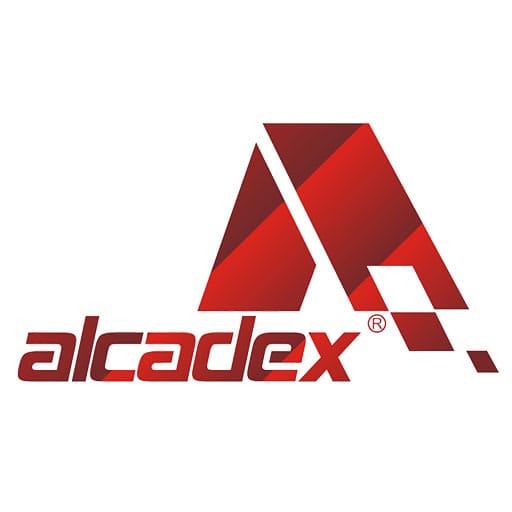

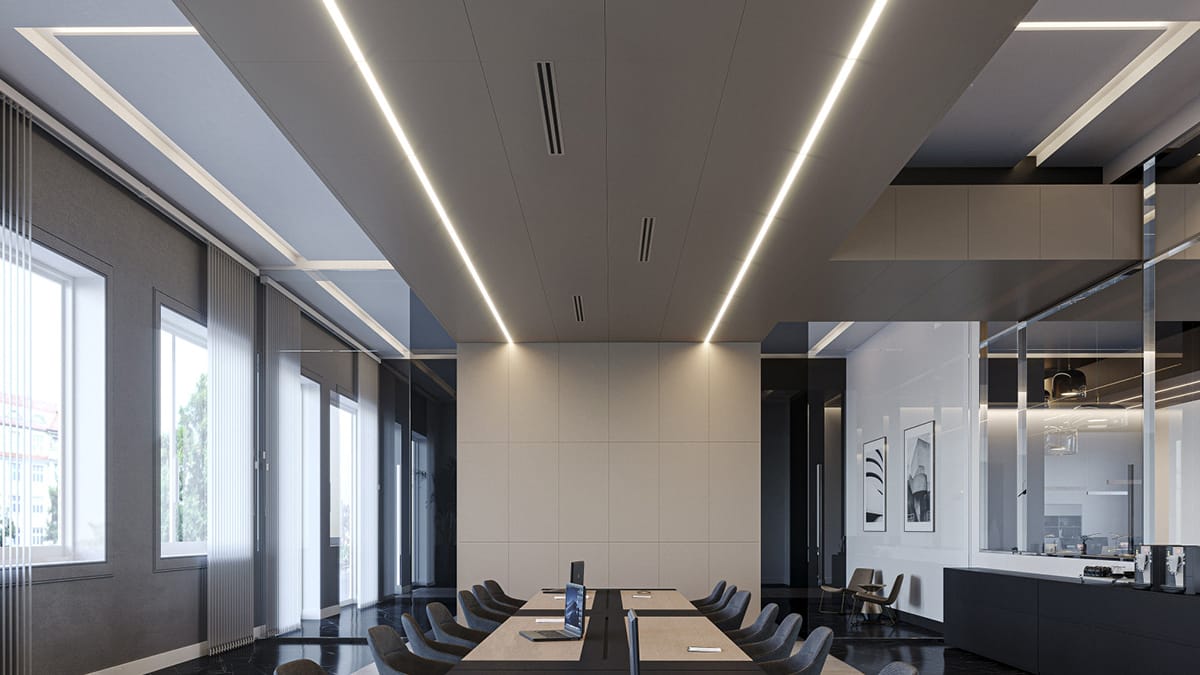 Durability
Durability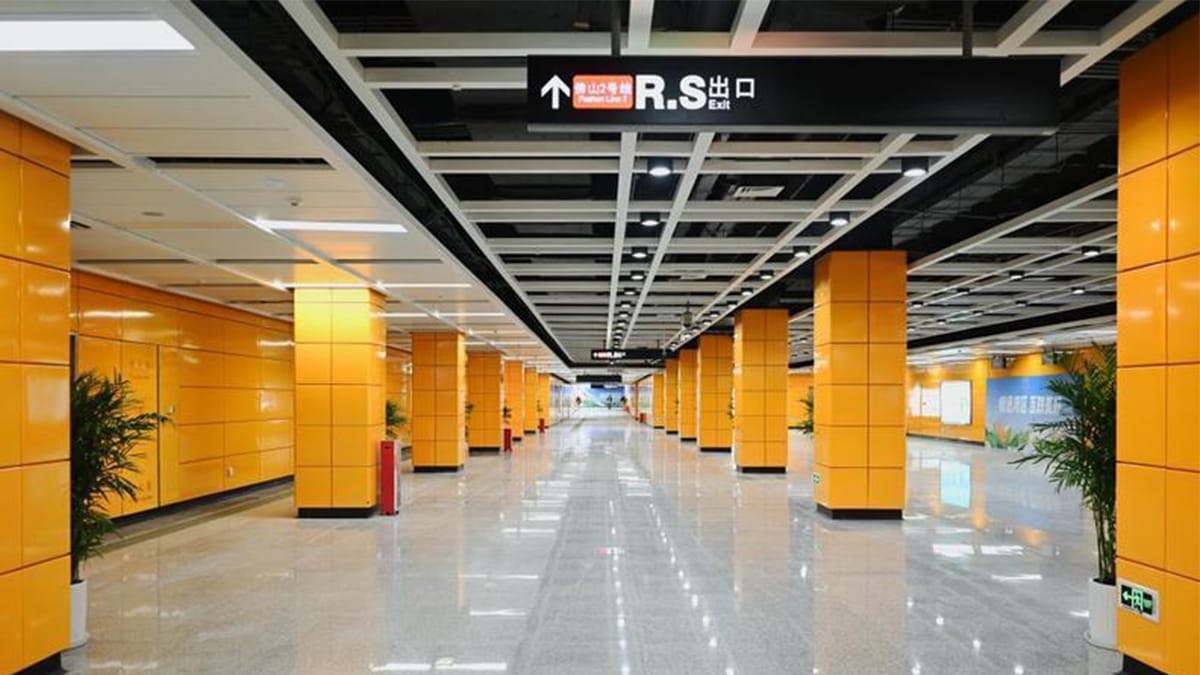 ACP Sheet Ceiling Styles
ACP Sheet Ceiling Styles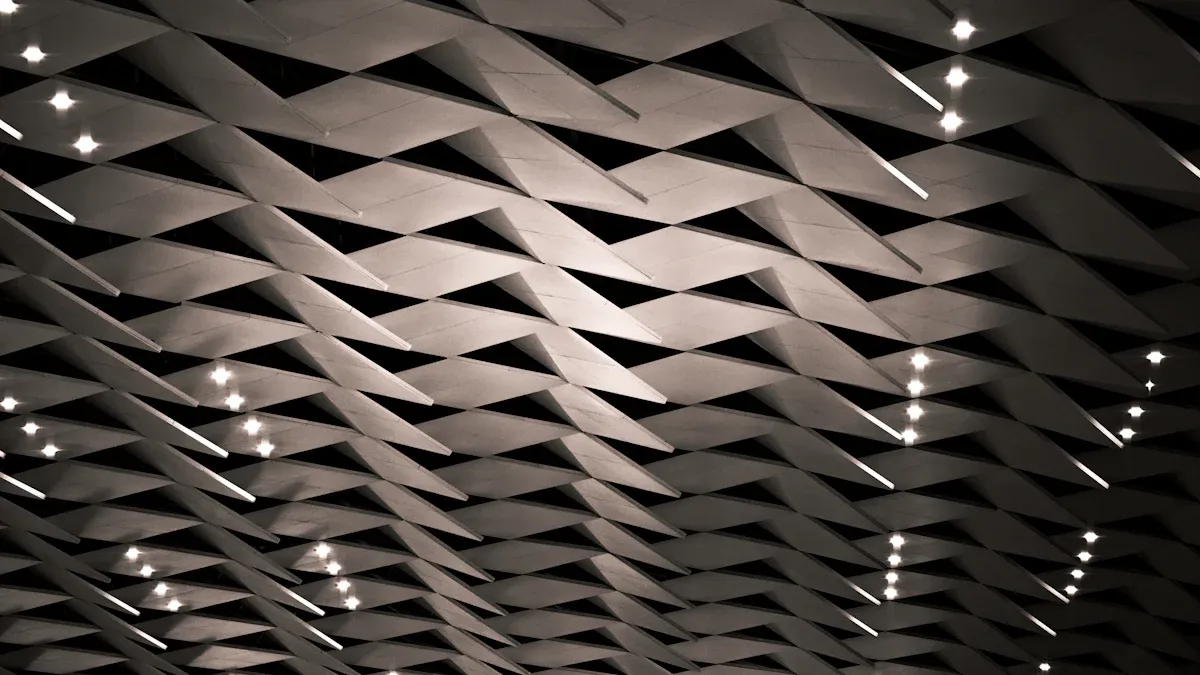 Upfront Costs
Upfront Costs